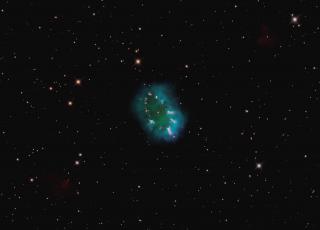Bibcode
Drew, J. E.; Gonzalez-Solares, E.; Greimel, R.; Irwin, M. J.; Küpcü Yoldas, A.; Lewis, J.; Barentsen, G.; Eislöffel, J.; Farnhill, H. J.; Martin, W. E.; Walsh, J. R.; Walton, N. A.; Mohr-Smith, M.; Raddi, R.; Sale, S. E.; Wright, N. J.; Groot, P.; Barlow, M. J.; Corradi, R. L. M.; Drake, J. J.; Fabregat, J.; Frew, D. J.; Gänsicke, B. T.; Knigge, C.; Mampaso, A.; Morris, R. A. H.; Naylor, T.; Parker, Q. A.; Phillipps, S.; Ruhland, C.; Steeghs, D.; Unruh, Y. C.; Vink, J. S.; Wesson, R.; Zijlstra, A. A.
Referencia bibliográfica
Monthly Notices of the Royal Astronomical Society, Volume 440, Issue 3, p.2036-3058
Fecha de publicación:
4
2014
Número de citas
258
Número de citas referidas
229
Descripción
The VST Photometric Hα Survey of the Southern Galactic Plane and
Bulge (VPHAS+) is surveying the southern Milky Way in u, g, r, i and
Hα at ˜1 arcsec angular resolution. Its footprint spans the
Galactic latitude range -5o < b < +5° at all
longitudes south of the celestial equator. Extensions around the
Galactic Centre to Galactic latitudes ±10° bring in much of
the Galactic bulge. This European Southern Observatory public survey,
begun on 2011 December 28, reaches down to ˜20th magnitude
(10σ) and will provide single-epoch digital optical photometry for
˜300 million stars. The observing strategy and data pipelining are
described, and an appraisal of the segmented narrow-band Hα filter
in use is presented. Using model atmospheres and library spectra, we
compute main-sequence (u - g), (g - r), (r - i) and (r - Hα)
stellar colours in the Vega system. We report on a preliminary
validation of the photometry using test data obtained from two pointings
overlapping the Sloan Digital Sky Survey. An example of the (u - g, g -
r) and (r - Hα, r - i) diagrams for a full VPHAS+ survey field is
given. Attention is drawn to the opportunities for studies of compact
nebulae and nebular morphologies that arise from the image quality being
achieved. The value of the u band as the means to identify
planetary-nebula central stars is demonstrated by the discovery of the
central star of NGC 2899 in survey data. Thanks to its excellent imaging
performance, the VLT Survey Telescope (VST)/OmegaCam combination used by
this survey is a perfect vehicle for automated searches for reddened
early-type stars, and will allow the discovery and analysis of compact
binaries, white dwarfs and transient sources.
Proyectos relacionados

Nebulosas Bipolares
Nuestro proyecto persigue tres objetivos principales: 1) Determinar las condiciones físico-químicas de las nebulosas planetarias con geometría bipolar y de las nebulosas alrededor de estrellas simbióticas. El fin es entender el origen de la bipolaridad y poner a prueba los modelos teóricos que intentan explicar la morfología y la cinemática nebular
Antonio
Mampaso Recio